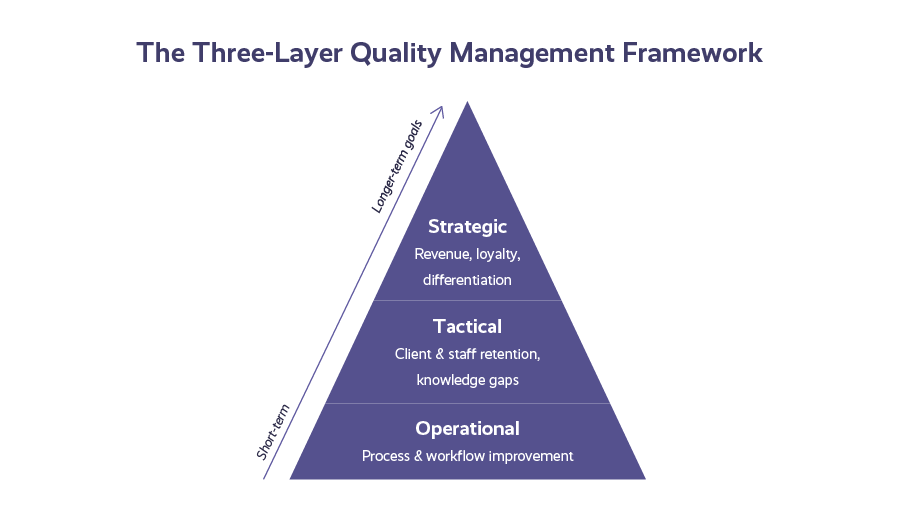8 Steps To Create A Quality Assurance Program From Scratch
If your company is growing quickly, it’s crucial to build a sturdy foundation as you scale your customer service support team and strive to deliver exceptional customer service. This strong foundation will allow your team to be on the same page and provide uniform customer service to accomplish your contact center goals.
But to achieve it, it’s important to start standardizing processes and setting the tone for the future. Enter: Your quality management (QM) program.

The Purpose Of A Quality Management Program
Focusing on quality management is the future for contact centers. It’s a more robust set of processes — including evaluation, dispute, calibration, and coaching — that you have to put in place to drive higher customer satisfaction and create better experiences.
Your program must address every level of quality management: operational, tactical, and strategic. By using the steps we discuss here, you can address the operational level, which will then drive change at the tactical and strategic levels.

Building a quality management program helps your organization minimize noncompliance and avoid customer experience mistakes and other errors that could occur internally.
By having standardized processes, you provide a structured work environment that makes it easier for contact center staff to know their responsibilities and help them focus on performing their job in the best way possible. In addition, a perfected quality management process can improve customer satisfaction, resulting in increased customer loyalty in the long run.
Is it difficult to build a quality management program? No! With a strategic approach, this vital undertaking can go smoothly. Here are eight steps and actionable insights to help you build a quality management program for your customer service support team from scratch.
1. Define Standards And Goals For Your Customer Service
As best-selling author and leadership expert Stephen Covey always advised, begin with the end in mind. Visualize what you want your contact center team to achieve and the continuous improvements you want them to make. Knowing which direction you want to take helps you define the next steps for building a QM program for your contact center agents.
In order to build a quality management program with excellent customer service at the heart, start by imagining what you want for your customers. Questions like these can lay the foundation for your quality goals:
- What kind of outcomes do you want your customers to have?
- What quality level of service do you hope your customers experience?
- How should each contact center interaction contribute to overall customer satisfaction?
- What role does customer service play in building customer loyalty?
- How should they feel when they finish with the call (or live chat or other digital interaction)?
- Is there anything you want them to do during or after the interaction?
- How do you want customers to perceive the brand as a result of contacting your customer service?
Now, consider how your team will bring these outcomes to life for your customers to boost service quality. As you build your quality management program, you must be mindful of what behaviors your agents will need to display to elicit these types of outcomes.
Set specific, ongoing goals that will define who you are as a customer service team in the long term and be clear about the standards you set. What Key Performance Indicators (KPIs) will you measure (First Contact Resolution, Service Level, etc.) and what results are acceptable? Many companies include these metrics in a performance scorecard, along with standard quality metrics.
When you’ve hashed out the quality details, develop a specific set of standards that apply to each facet of the work. Make a separate, concise list of your overarching goals, and never be afraid to offer constructive feedback to your contact center agents as they strive to achieve these goals.
2. Set Policies And Procedures For Each Department
A quality control plan requires effort from the entire team, and everyone in your company must be involved to achieve the quality outcomes you want. To that end, create a set of procedures adapted to each department and level so all staff members can participate and take action on your newly established quality policy.
The quality policies need to spell out how various situations should be handled. They also need to set expectations about attendance, overtime, and conduct on the job. Procedures should cover everything from how customer interactions are to be handled to how and when agents can expect feedback. Don’t forget to include your quality metrics.
If your organization doesn’t already have one, consider developing a Standard Operating Procedures manual. Here, you’ll store all your long-term policies and procedures once they’re finalized. Your team will appreciate having all relevant processes in one central repository that’s easy to reference.
Related Article: Why Your Contact Center Needs A Call Avoidance Policy
3. Share The News
Once your organization’s quality plans are developed and carefully outlined, communicate the new quality requirements and procedures with your staff. Before making a big announcement, discuss the rollout with the leaders of each department.
Talking to your managers first prepares them for the changes ahead and allows them to prepare front-line employees and handle questions that arise. The long-term success of your quality plans — and overall quality level— depends on a strong launch.
With all of your key leaders informed and prepared to address questions, communicate your QM plan to your team members. If you’re only making a few changes to your quality goals, having the managers touch base with each employee to explain the changes in question may be sufficient.
If this is your first formal contact center quality management program, you’ll need to spend more time ensuring everyone is well-informed about what you’ve created. Consider having a special work session or an all-hands meeting to review the new quality management plan.
Start with the overall concept of quality management to explain the “why” behind these efforts. Make sure to address the role QA plays in customer satisfaction and meeting customer expectations and discuss major changes for expectations going forward. Part of a successful QM program (and overall customer loyalty as a result) is getting everyone in the office on board.
Related Article: Three Secrets to Building Customer Loyalty in the Call Center
4. Implement The Procedures
Now the fun really begins. Collaborating with the different heads of departments, work together to implement the new policies and procedures. You can do this through agent training programs, one-on-ones, and continuous feedback with employees.
Initially, it’s normal for doubts to arise. While everyone shares the long-term goal of building customer loyalty, there may be questions about the quality plan at first. So your job is to address any questions and concerns for both managers and front-line employees.
Ensure adherence to the new procedures through regular tracking and reporting. Quality management solutions can be critical for this.
Build your quality management program correctly by having a clear-cut switch date between the old and new systems. Give your team reminders in the days and weeks leading up to the change. Then, on the day of the switch, get everyone on board with a clear announcement that the new QM program starts with the first shift.
Managers might need to remind people during the first few days if agents are struggling to implement the new plan. (Again, quality management solutions can be game-changers here.) Remember, this is a learning experience for everyone.
Even if they’ve had comprehensive training, it’s easy to fall into old habits during the first few customer interactions. Be patient but firm in insisting they adhere to the quality expectations you set. Although your ideal outcome may be an immediate increase in customer satisfaction scores, the development phase takes time.
5. Get Feedback
A few weeks or months after implementing your new quality standards, organize discussion and feedback sessions among managers. Then ask them to meet with their teams to hear about their experiences with the new QM program. By allowing for 360-degree feedback, you’ll empower the entire organization to take ownership of the quality level and reduce agent turnover.
Take a problem-solving approach with your sessions during this critical phase as you fine-tune the QM plan you’ve created. Give your managers a safe space to bring up questions and problems, but don’t allow your meetings to become pointless complaint sessions. Remind team members of the overall concept of quality management, and how it can be a game-changer in meeting customer expectations.
Focus on the shared goals of customer satisfaction, high quality standards, and long-term customer loyalty. Use your quality management scorecards to realign everyone on what your organization is chasing.
You might hear questions or comments you need to research more, or you might identify an opportunity to create more well-defined procedures. That’s okay. These feedback sessions aim to explore issues about your internal processes, not solve them once and for all.
6. Measure Results
As you get feedback, analyze and measure agent performance and customer satisfaction to see what progress the well-defined procedures have created. During these quality audits, it’s important to analyze KPIs before and after the implementation and review interactions with customers.
Refer to the initial goals and expectations you set for the program when you first created your QM plan and see if you’ve met those objectives in the given time frames. You also need to measure other outcomes that were already in good shape before the change. By doing this, you can ensure that you’ve improved your team’s overall quality level without harming the positive outcomes you had before.
Related Article: Customer Service Metrics You Should Be Paying Attention To
7. Communicate Results
There’s nothing more motivating to staff than knowing their actions have significantly improved their organization. Regular reporting of your quality management results can maintain the buy-in you worked hard to achieve in the first place. An increase in customer satisfaction and improvement in customer loyalty can be directly tied to the actions of front-line employees.
Let employees know about the direct impact they had on their company. After all, it’s because of your team that you successfully established new quality management and standard operating procedures. By motivating and empowering staff, they’ll be able to better embrace your vision and continue to power forward, meeting even the highest customer expectations.
Beyond verbal affirmations, you can drive the message home even more by effectively rewarding exceptional adherence to the new plan. Positive outcomes for your customers and your company are critical. To achieve those quality management wins, you need your team members to follow your plan and provide more feedback if needed. So, reward compliance regardless of the results.
In addition to measuring KPIs, do some testing to ensure your managers and agents understand the changes clearly. Then, clear up any quality management misunderstandings one on one and with all your managers.
Related Article: 13 Easy and Creative Contact Center Rewards and Recognition Ideas
8. Adjust As Needed
Remember, when the procedures and policies were defined for your QM program, it was all in theory. Now that you have gathered both feedback and measurable results from your quality processes, it’s time to analyze gaps and areas for improvement to tweak the procedures as necessary. This could be done by getting more feedback to spot weaknesses, providing improved training, and conducting deeper customer experience analysis.
Hold a special meeting to discuss what might be done about quality management problem areas and how to enhance employee performance in efforts to reach your customer service goals. If there are business standards you can change in quality control, do so. If there are other things you aren’t willing to change, let the managers know that, too. Otherwise, you can confuse them about the details of the quality control program.
Add the changes to the digital or paper document where you’ve given your policies and procedures, whether that’s a formal SOP manual or a simple listing of the new quality control rules. Assign a quality team to spread out across different departments and report concerns back to you.

Keep Your QM Efforts Fresh
Just because your customer service quality works now doesn’t mean it will work in a year. Get continuous feedback, measure and communicate results, and regularly adjust as needed. This can be done once or twice a year. The idea is to keep up with the changing and dynamic customer trends, always striving for the gold standard in your contact center quality management program.
Although you may never change your mind about what you want your team to achieve, advances in technology and the industry are bound to change how everyone needs to go about their daily tasks to accomplish those goals. That’s where these steps to create a quality management program from scratch come in. Stay flexible in how you achieve your agent performance goals and, no matter what might change, keep your team focused on them at all times.
For more information about contact center quality management programs, schedule a demo with Playvox.






